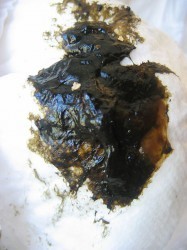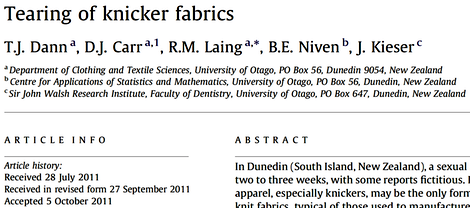Marc Abrahams's Blog, page 582
April 3, 2012
Billiard balls versus the earth
"All balls must be composed of cast phenolic resin plastic and measure 2 ¼ (+.005) inches [5.715 cm (+ .127 mm)] in diameter and weigh 5 ½ to 6 oz [156 to 170 gms]. Balls should be unpolished, and should also not be waxed. Balls should be cleaned with a towel or cloth free of dirt and dust, and may also be washed with soap and water."
That's part of the official World Pool-Billiards Association . An analyst at the Curiouser.com web site uses it in constructing a "Proof that the Earth is smoother than a billiard ball". That proof says, in part:
… This means that balls with a diameter of 2.25 inches cannot have any imperfections (bumps or dents) greater than 0.005 inches. In other words, the bump or dent to diameter ratio cannot exceed 0.005/2.25 = 0.0022222
The Earth's diameter is approximately 12,756.2 kilometres or 12,756,200 metres…. So, if a billiard ball were enlarged to the size of Earth, the maximum allowable bump (mountain) or dent (trench) would be 28,347 metres. Earth's highest mountain, Mount Everest, is only 8,848 metres above sea level. Earth's deepest trench, the Mariana Trench, is only about 11 kilometres below sea level. So if the Earth were scaled down to the size of a billiard ball, all its mountains and trenches would fall well within the WPA's specifications for smoothness.
The Association's very logo, reproduced here, seems to suggest as much:
[HT Cliff Pickover]
BONUS: Proof that Kansas Is Flatter Than a Pancake
CRYPTIC BONUS: Today's meaningless code phrase is: sciseekclaimtoken-4f7b10b296ef7

April 2, 2012
The German beer belly is misunderstood [study]
A team of scientists has attacked the idea that beer is the main cause of beer bellies in Germans. As with many biomedical questions, an absolute, indisputable answer may be impossible. To obtain it would require continuously monitoring and measuring, over a span of years, every sip and morsel drunk and eaten by a vast number of people.
The only practical method involves asking beer-drinkers to dig deep into their memory and estimate or take a wild guess as to their typical intake of beer and everything else that has passed down their gullet.
Madlen Schütze and other researchers at the German Institute of Human Nutrition Potsdam-Rehbrücke and at Fulda University of Applied Sciences, together with a colleague at the University of Gothenburg, Sweden, gave it their best shot. They published a study in 2009 in the European Journal of Clinical Nutrition.
The team analysed 19,941 men and women's weight, waist measurements and hip circumference…
So begins this week's Improbable Research column in The Guardian.
BONUS: Scicurious analyzes the study
BONUS: "Scantily clad German men happy to bare their beer bellies"
BONUS: "German beer lover goes down the drain"

Dudley Herschbach, Ben Franklin, Ig Nobel in St. Louis
If you are in St. Louis on April 4, treat yourself to a talk by Dudley Herschbach. Here's the announcement from Washington University in St. Louis:
Dudley Herschbach,"Silly Serious Science: Homage to Ig Nobel and Ben Franklin" 4 p.m. Wednesday, April 4, Graham Chapel
In 2011, the Ig Nobel Award in chemistry was given for designing a method to wake sleepers during a fire by flinging wasabi horseradish at them. Goofy, yes; inconsequential, definitely not.
For the uninitiated, the Ig Nobel Awards, invented by Marc Abrahams, editor of Annals of Improbable Research (AIR), and complete with its own ceremony and traditions, appear to mock scientific inquiry. But the experiments are designed, in the words of NPR "Science Friday" host Ira Flatow, "to first make you laugh, then make you think."
Many otherwise serious scientists, such as Herschbach, PhD, Nobel l aureatein chemistry (1986), view the Igs as complementary to the prizes Alfred Nobel launched in 1901.
As a long-time participant and judge, Herschbach thinks that science and humor have been a winning combination for many successful Americans, all the way back to Ben Franklin. Herschbach is delivering the annual Ferguson Science Lecture.

April 1, 2012
Prof. Nishiyama – #5 – Boomerangs all round
Many may have asked the questions 'Why are boomerangs crescent-shaped?' and 'Why do boomerangs come back?' – but few, however, are in a position to provide scientific explanations – aside, that is, from Prof. Yutaka Nishiyama of the Osaka University of Economics, Japan. In his article 'Why Do Boomerangs Come Back?' (Bulletin of Science, Technology & Society, Vol.22, No.1, 13-20,Feb 2002.) he answers both, with references to Bernoulli's Principle, gyroscopes, inertial moments, the 'right-hand-rule', and more. Noting, for example :
"A boomerang, along with making a left turn when thrown vertically, also makes a sideways fall and returns in a horizontal position. Difference in the lift force between the top and bottom of the wing forms the force to left-turn the boomerang, whereas the difference in the lift force between front and back of the wings forms the force to make a boomerang fall sideward"
The professor also provides (via the Kansai Boomerang Network) a comprehensive set of instructions on how to construct and operate a three-bladed boomerang made out of cardboard – which he has personally translated into 70 different languages.
"Recommend this boomerang to your friends, or neighbors for world peace!"
Note: Professor Nishiyama is Honored Director of the Japan Boomerang Association.
Also see: Boomerangs, the aerodynamics of - regarding work by Alexander S. Kuleshov, at the Department of Mechanics and Mathematics, of Московского государственного университета.
Also see as well: Previous Improbable notes regarding professor Nishiyama : Here, Here, Here and Here.

Reassessment of the role of penguin emissions
The time has come, the walrus said, for a reassessment of the role of penguin emissions:
"A reassessment of the budget of formic and acetic acids in the boundary layer at Dumont d'Urville (coastal Antarctica): The role of penguin emissions on the budget of several oxygenated volatile organic compounds," Michel Legrand [pictured below], Valérie Gros, Susanne Preunkert, Roland Sarda-Estève, Anne-Mathilde Thierry, Guillaume Pépy, and B. Jourdain, Journal of Geophysical Research, J. Geophys. Res., vol. 117, 2012, D6. The authors, at Laboratoire de Glaciologie et Géophysique de l'Environnement, Grenoble, France, at Unité Mixte, Gif sur Yvette, France, and at Institut Pluridisciplinaire Hubert Curien, Strasbourg, France, report:
"Acetic acid levels in December 2010 were four times higher than those observed over summers back to 1997. These unusually high levels were accompanied by unusually high levels of ammonia, and by an enrichment of oxalate in aerosols. These observations suggest that the guano decomposition in the large penguin colonies present at the site was particularly strong under weather conditions encountered in spring 2010….
Present at levels as high as 500 pptv, acetaldehyde may represent the major precursor of acetic acid, alkene-ozone reactions remaining insignificant sources. Far less influenced by penguin emissions, the budget of formic acid remains not fully understood even if alkene-ozone reactions contribute significantly."
(Thanks to investigator Tom Gill for bringing this to our attention.)
BONUS: The Ig Nobel Prize-winning report "Pressures Produced When Penguins Pooh — Calculations on Avian Defaecation."

March 31, 2012
Culinary medical terms for human feces

Meconium - newborn stool
Various foods are in contemporary use as analogies for the stool (human feces) found in certain medical conditions. Below is a selection of such food-related medical stool metaphors:
butter stool – of excess fecal fat
pea-soup stool – of typhoid fever
red-currant jelly stool – of intussusception
rice-water stool – of cholera
BONUS: Pea-soup stool can also be used to describe a newborn's green thick sticky stool known as meconium (Murray ML. Antepartal and Intrapartal Fetal Monitoring, 3rd Edition. Springer Publishing Company, page 262.)

Pea soup (in the plate with the spoon)

Sarcastic fringehead (fish of the day)
The sarcastic fringehead (Neoclinus blanchardi) is this week's Fish of the Day. Enthusiasts will (or won't) enjoy this puzzler from Mark W. Denny and Steven Gaines's book Chance in biology: using probability to explore nature:
Suppose that a displaced sarcastic fringehead must spend approximately three hours searching for a new shelter. Lets' also assume that each day involves four encounters with invading fringeheads…. How much time will a fringehead waste in a typical day searching for a new shelter?
(Thanks to investigator Lance Gharavi for bringing this to our attention.)

Theory 'o Everything: Rats, Coffee, Drugs, Booze, Decisions
A new study involves rats, coffee, amphetamines, booze, decision-making, and lots more. It answers a good percentage of the questions you might care to ask about psychology or anything else. The study is:
"Sensitivity to Cognitive Effort Mediates Psychostimulant Effects on a Novel Rodent Cost/Benefit Decision-Making Task," Paul J Cocker, Jay G Hosking, James Benoit and [pictured here], Neuropsychopharmacology, epub March 28, 2012. The authors, at the University of British Columbia, explain, with plenty of words:
"Amotivational states and insufficient recruitment of mental effort have been observed in a variety of clinical populations, including depression, traumatic brain injury, post-traumatic stress disorder, and attention deficit hyperactivity disorder. Previous rodent models of effort-based decision making have utilized physical costs whereas human studies of effort are primarily cognitive in nature, and it is unclear whether the two types of effortful decision making are underpinned by the same neurobiological processes. We therefore designed a novel rat cognitive effort task (rCET) based on the 5-choice serial reaction time task, a well-validated measure of attention and impulsivity. Within each trial of the rCET, rats are given the choice between an easy or hard visuospatial discrimination, and successful hard trials are rewarded with double the number of sugar pellets. Similar to previous human studies, stable individual variation in choice behavior was observed, with 'workers' choosing hard trials significantly more than their 'slacker' counterparts. Whereas workers 'slacked off' in response to administration of amphetamine and caffeine, slackers 'worked harder' under amphetamine, but not caffeine. Conversely, these stimulants increased motor impulsivity in all animals. Ethanol did not affect animals' choice but invigorated behavior. In sum, we have shown for the first time that rats are differentially sensitive to cognitive effort when making decisions, independent of other processes such as impulsivity, and these baseline differences can influence the cognitive response to psychostimulants. Such findings could inform our understanding of impairments in effort-based decision making and contribute to treatment development…."
BONUS: The University of British Columbia's press release about the study and its ramifications.

March 30, 2012
Toothaker restores lost teeth
A University of Nebraska Medical Center press release (from 2002) tells the happy news about a dauntingly-named dentist:
Randy Toothaker, D.D.S., center, holds an articulator, which allows a restorative dentist to study a patient's replicated jaw movements in order to accurately design and fabricate a prostheses upon dental implants.
In 2011, Dr. Toothaker is still hard at work, restoring teeth, according to an article with photos by the Omaha World-Herald.

A new twist in forensic knicker-testing
A study in New Zealand tested the tearing of knickers, and found that meaningful results are not easy to obtain if one examines only the fabric itself:
"Tearing of Knicker Fabrics," T.J. Dann, D.J. Carr, R.M. Laing, B.E. Niven and J. Kieser, Forensic Science International, 217 (2012) 93–100. (Thanks to investigator Erwin Kompanje for bringing this to our attention.) The authors, at the University of Otago, report:
"In Dunedin (South Island, New Zealand), a sexual assault is reported to police approximately once every two to three weeks, with some reports fictitious. Identifying a fictitious claim is difficult, and damage to apparel, especially knickers, may be the only form of evidence….
"The aim of this work was to investigate (i) the tearing behaviour of fabrics commonly used to manufacture knickers available in New Zealand, (ii) the effect of laundering on tearing fabrics, and (iii) the appearance of damage caused by tearing….
"Torn fibre ends appeared similar to those damaged by other means (e.g. knife, screwdriver) and no features visible underfield emission scanning electron microscope could be attributed solely to tearing damage in the fabrics studied."
Detail from the report—a photo of the machine used to do the testing:

Marc Abrahams's Blog
- Marc Abrahams's profile
- 14 followers

























